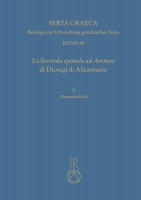Search
La seconda epistola ad Ammeo di Dionigi di Alicarnasso
Studi sulla tradizione manoscritta
2023
17.0 x 24.0 cm, 200 p., 44 illustrations color, 14 Tafeln, cloth
ISBN: 9783954905379
go to ebook version
17.0 x 24.0 cm, 200 p., 44 illustrations color, 14 Tafeln, cloth
98,00 €
ISBN: 9783954905379
go to ebook version
Short Description
In this book, Alessandra Palla provides the first comprehensive investigation into the manuscript tradition of the Dionysius of Halicarnassus’ De thucydidis idiomatibus, commonly known as Epistula ad Ammaeum II. The extensive study of all the manuscripts and the innovative results allow for a new reconstruction of the stemmatical relationships between the witnesses of the Epistula. The present work demonstrates the pressing need for a historical-critical edition with a commentary, a project that Palla is currently engaged in.Description
In this essay, Alessandra Palla provides the first comprehensive investigation into the manuscript tradition of the Dionysius of Halicarnassus’ De thucydidis idiomatibus, commonly known as Epistula ad Ammaeum II. While previous studies adopted the findings reported in research conducted by H. Usener at the end of the 19th century, the present work demonstrates significant progress, notably with respect to the detailed heuristic of all the manuscripts of the Epistula. In this regard, Palla includes for the first time ten manuscripts, dated between the 14th and 16th centuries, unknown or disregarded by previous scholars. Furthermore, the author examines a thus far neglected parchment fragment, currently conserved at the Archive of State of Modena, likely dating from the second half of the 10th century. Despite its limited size, the Modena fragment is significant and this, together with the results of the recensio, allows for a new reconstruction of the manuscript tradition of the Epistula. In contrast to previous studies, it is now possible to trace almost half of the witnesses of the Epistula to the Parisinus gr. 1741 (siglum P), dated to around the mid-10th century. The other witnesses are traceable to a lost manuscript (siglum Θ), which, as the Modena fragment proves, we can now assume is slightly less old than P.The present study identifies P and Θ as the primary witnesses of the Epistula. It reconstructs the descent of both the manuscripts until the editiones principes and registers the respective Trennfehler of P and Θ, including the Bindefehler. It thus identifies P and Θ as deriving from the same archetype (siglum Ω).
Alessandra Palla reconstructs in detail the manuscript tradition and the legacy of the Epistula in different times and in multifaceted cultural contexts. Furthermore, the author defines the filiation between the extant witnesses. It is thus possible to provide for the first time the stemma codicum of the Epistula.




 Table of Contents
Table of Contents

 Neuerscheinungen 2023/2024
Neuerscheinungen 2023/2024
 Gesamtverzeichnis 2023/2024
Gesamtverzeichnis 2023/2024
 Katalog Oriental Studies & Linguistics
Katalog Oriental Studies & Linguistics
 Mittelalter
Mittelalter
 Deutsche Inschriften
Deutsche Inschriften
 Musiktherapie
Musiktherapie
 Literaturen im Kontext
Literaturen im Kontext